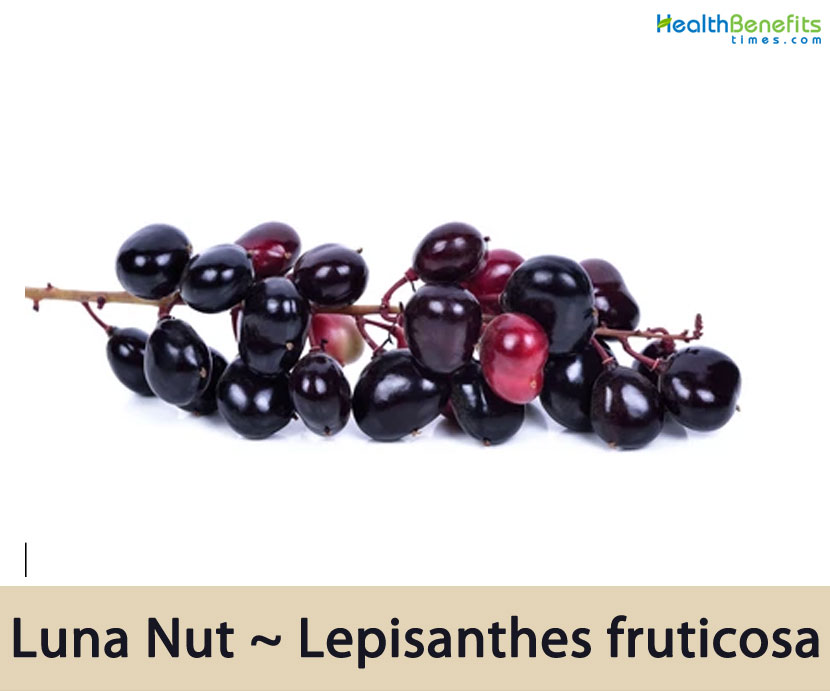| Luna Nut Quick Facts | |
|---|---|
| Name: | Luna Nut |
| Scientific Name: | Lepisanthes fruticosa |
| Origin | Southeast Asia: Myanmar, Indo-China, Thailand, Malaysia, Philippines, Indonesia – Kalimantan, Sumatra, Java to the Moluccas |
| Colors | Green when young turning to dark red to reddish-black when ripe |
| Shapes | Subglobose to ovoid (-ellipsoid), 3–4 cm diameter, glossy, thin-walled, with sweet, translucent, fleshy aril |
| Health benefits | Support relieving itching, lower temperature during fever, rheumatism, impotence, relive backache, enhance sexual desires and cure restlessness |
Plant Description
Luna nut is an erect shrub or small tree that normally grows from 1.5 – 10 meters tall, but exceptionally to 15 meters. The bole can be 2 – 15 cm in diameter. The plant is found growing in primary and secondary vegetation, probably in open places in the forest, along the edges, on ridges, along rivers and streams, swamp edges, the beach, logged areas, moist thickets, on ridges, abandoned plantations and grasslands. Plants are found in the wild in a wide range of situations and in soils ranging from dry to swampy; rich as well as poor; clayey as well as sandy; acid as well as basic. In secondary forests, it is usually present as a pre-disturbance remnant. Twigs are reddish when young becoming brown to silvery grey, smooth or lenticellate and glabrescent.
Luna Nuts Facts
| Name | Luna Nut |
|---|---|
| Scientific Name | Lepisanthes fruticosa |
| Native | Southeast Asia: Myanmar, Indo-China, Thailand, Malaysia, Philippines, Indonesia – Kalimantan, Sumatra, Java to the Moluccas |
| Common Names | Luna nut |
| Name in Other Languages | Borneo : Kilinga Cambodia: kandak English: Luna nut Indonesia : Blimbing Cina, Cereme Cina, Mojowontu Kedayan: Belingasan Khmer: Kandak, Kândâk Laos: Kwad Khaaz Malaysia : Setengok, Talikasan, Palingsan Bukit, Petagar Tulang, Mojowontu Murut: Lulupitan Philippines : Buli-Buli, Ara, Balinaunau, Linaunau Thailand : Chammaliang (ชำมะเลียง), Chammaliang baan (ชำมะเลียง บ้าน), Khomriang (โคมเรียง), Mathao (มะเถ้า), Phumriang (พุมเรียง), Phumriang suan (พุมเรียงสวน), Phuuwiang (พูเวียง), Mathao Tagalog: Linaunau Vietnamese: Bắp muôi Visayan: Buli-buli |
| Plant Growth Habit | Erect shrub or small tree |
| Growing Climates | Primary and secondary vegetation, probably in open places in the forest, along the edges, on ridges, along rivers and streams, swamp edges, the beach, logged areas, moist thickets, on ridges, abandoned plantations and grasslands |
| Soil | Plants are found in the wild in a wide range of situations and in soils ranging from dry to swampy; rich as well as poor; clayey as well as sandy; acid as well as basic. In secondary forests, it is usually present as a pre-disturbance remnant |
| Plant Size | Usually growing from 1.5 – 10 meters tall, but exceptionally to 15 meters. The bole can be 2 – 15cm in diameter |
| Twigs | Twigs are reddish when young becoming brown to silvery grey, smooth or lenticellate and glabrescent |
| Leaf | Leaves alternate, paripinnate, 2–8(14)-jugate, penninerved, coracious, glossy and glabrous, young leaves pinkish becoming green with age, rachis not winged. Pseudo stipules present, ovate to elliptic and persistent |
| Leaflets | Leaflets are opposite to sub opposite, elliptic to lanceolate, apex obtuse to acuminate, margin entire |
| Flower | Flowers are scentless, bisexual,0.3–0.4 × 0.5– 0.6 cm, with of 4–5 elliptic, ovate, or obovate, reddish sepals, 4–5 elliptic to obovate dark red, glabrous petals, stamens 5–8 with yellow or white anthers, ovary 2–3(−4) locules, glabrous, stigma slightly lobed and sub sessile |
| Fruit Shape & Size | Subglobose to ovoid (-ellipsoid), 3–4 cm diameter, glossy, thin-walled, with sweet, translucent, fleshy aril. |
| Fruit Color | Green when young turning to dark red to reddish-black when ripe |
| Seed | Seeds are usually 2, brown, subglobose to ellipsoid, flattened on the axial side. |
| Propagation | By seed |
| Plant Parts Used | Root |
Leaves
Leaves are alternate, paripinnate, 2–8(14)-jugate, penninerved, and coracious, glossy and glabrous. Young leaves are pinkish and become green with age, rachis is not winged. Pseudo stipules are present and are ovate to elliptic and persistent. Leaflets are opposite to sub opposite, elliptic to lanceolate, apex obtuse to acuminate and margin entire.
Flower
Inflorescence is axillary or terminal, sometimes ramiflorous and cauliflorous. Flowers are scentless, bisexual,0.3–0.4 cm long and 0.5– 0.6 cm wide, with of 4–5 elliptic, ovate, or obovate, reddish sepals, 4–5 elliptic to obovate dark red, glabrous petals, stamens 5–8 with yellow or white anthers, ovary 2–3(−4) locules, glabrous, stigma slightly lobed and sub sessile.
Fruits
Fertile flowers are followed by subglobose to ovoid (-ellipsoid) fruit, 3–4 cm diameter, glossy, thin-walled, with sweet, translucent, fleshy aril. Fruits are dark red to reddish-black when ripe. Seeds usually 2 are brown, subglobose to ellipsoid, flattened on the axial side.
Traditional uses and benefits of Luna Nuts
- In traditional Malay medicine, the root is used in a compound poultice to relieve itching and to lower temperature during fever.
- The Kedayan in Sarawak use a tea infusion of the root regularly against rheumatism or impotence.
- A tea is made from its roots and the roots of pasak nagi (Euphorbiaceae) and drank to relive backache and to enhance sexual desires.
- Root is used to cure heat in restlessness as well as fever.
Culinary Uses
- The fruit can be eaten fresh, as it is sweet when ripe.
- The seeds are eaten roasted.
- Young leaves eaten cooked as vegetables in southern Thailand.
Other Facts
- The tree is used as an ornamental plant in landscaping due to its attractive form.
- Wood is hard, durable, and heavy and is used for house building in Malacca and also used for firewood.
- Shoots are used in a pre-harvest rice ritual in southern Thailand.
References:
http://www.theplantlist.org/tpl1.1/record/tro-100362110
http://tropical.theferns.info/viewtropical.php?id=Lepisanthes+fruticosa
https://asianplant.net/Sapindaceae/Lepisanthes_fruticosa.htm
Comments
comments
